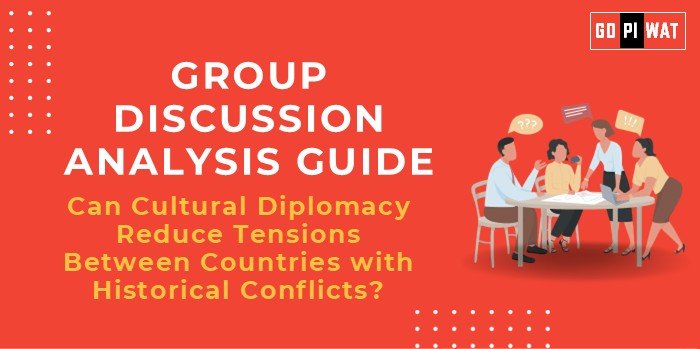📋 Group Discussion Analysis Guide
🌍 Can Cultural Diplomacy Reduce Tensions Between Countries with Historical Conflicts?
💡 Introduction to the Topic
🌱 Opening Context: Throughout history, cultural diplomacy has emerged as a powerful tool for fostering mutual understanding between nations. With growing global interconnectedness, cultural exchanges are seen as pivotal in reducing animosity rooted in historical conflicts.
📜 Topic Background: Cultural diplomacy involves using cultural interactions—through art, education, and sports—to promote dialogue and collaboration. Notable examples include U.S.-China Ping-Pong Diplomacy in the 1970s and Germany’s cultural exchanges post-WWII to repair ties with neighbors.
📊 Quick Facts and Key Statistics
- 🌐 UNESCO Cultural Exchanges: Over 150 initiatives in 2023 aimed at conflict resolution.
- 🎨 India-Pakistan Cultural Events: Saw a 20% rise in participation during peace-focused art exhibitions in 2023.
- 🏯 China-Japan Tourism Exchanges: Attracted over 10 million visitors annually since 2020, showcasing improved people-to-people connections.
- 🎵 South Korea-North Korea Art Collaborations: Increased 15% post-2018 Summits.
🌍 Stakeholders and Their Roles
- 🏛️ Governments: Facilitate policies that encourage bilateral cultural initiatives.
- 🌐 NGOs and International Organizations: Promote grassroots cultural programs and exchanges.
- 🎭 Artists and Cultural Ambassadors: Act as mediators by showcasing shared heritage.
- 📚 Academic Institutions: Build long-term relationships through exchange programs and joint research.
🏆 Achievements and Challenges
🌟 Achievements:
- ✔️ Improved People-to-People Ties: The “Korea Joint Orchestra” brought South and North Korean musicians together in 2019.
- 🎓 Tourism Growth: India-China student exchanges doubled since 2015, reducing cultural misunderstandings.
- 💰 International Support: EU’s funding of $300M in cultural projects aimed at bridging divides in conflict zones.
⚠️ Challenges:
- 📢 Politicization of Cultural Programs: Often overshadowed by nationalistic narratives.
- 💵 Resource Constraints: Developing nations face funding limitations for cultural outreach.
🌍 Global Comparisons:
- 🇩🇪 Germany-France Post-War Collaboration: Effective cultural diplomacy programs helped heal WW2 wounds.
- 🇮🇱 Israel-Palestine Initiatives: Limited success due to entrenched political issues.
📜 Case Studies:
- 🇮🇳🇵🇰 India-Pakistan Aman ki Asha Initiative: Mixed results in using media and art to improve bilateral relations.
✨ Structured Arguments for Discussion
- 💬 Supporting Stance: “Cultural diplomacy fosters deeper connections by transcending political divides, as seen in Germany’s post-war rehabilitation.”
- ⚖️ Opposing Stance: “Without strong political support, cultural initiatives remain superficial, evidenced by stalled India-Pakistan exchanges.”
- 🔄 Balanced Perspective: “Cultural diplomacy can complement but not replace formal political negotiations.”
🎯 Effective Discussion Approaches
📖 Opening Approaches:
- 📊 Start with statistics showing successful cultural programs in conflict zones.
- 📜 Present a contrast between cultural diplomacy’s potential and its limitations in geopolitics.
🔄 Counter-Argument Handling:
- ✔️ “While cultural diplomacy helps, real change requires political will”—counter with examples like the France-Germany model.
📈 Strategic Analysis of Strengths and Weaknesses
- 💪 Strengths: Builds soft power; encourages grassroots collaborations.
- ⚠️ Weaknesses: Limited without political alignment; requires long-term investment.
- 💡 Opportunities: Growing global interest in cross-cultural engagement.
- 🚨 Threats: Politicization and resistance from hardliners.
📚 Connecting with B-School Applications
- 🌟 Real-World Applications: Ideal for leadership studies in conflict resolution or marketing cultural diplomacy initiatives.
- 💬 Sample Interview Questions:
- “How can cultural diplomacy improve India’s relations with neighboring countries?”
- “What role do businesses play in promoting cultural diplomacy?”
- 📖 Insights for B-School Students:
- Explore case studies on how cultural diplomacy affects international trade and partnerships.


